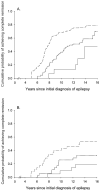Complete remission in nonsyndromic childhood-onset epilepsy
- PMID: 21710620
- PMCID: PMC3183287
- DOI: 10.1002/ana.22461
Complete remission in nonsyndromic childhood-onset epilepsy
Abstract
Objective: Determine the probability of attaining complete remission in children with nonsyndromic epilepsy (NSE) over the course of ≥10 years from initial diagnosis; identify early predictors of complete remission; and assess the risk of relapse after achieving complete remission.
Methods: In a prospective community-based cohort, complete remission was defined as 5 years seizure-free and medication-free. Any subsequent seizure for any reason was a relapse. Univariate and bivariate analyses were conducted with standard methods including the Kaplan-Meier approach. Proportional hazards modeling was used for multivariable analysis.
Results: Of 613 cohort members, 347 had NSEs, of whom 294 (85%) were followed ≥10 years (maximum = 17.9). A total of 170 in 294 (58%) achieved complete remission, 10 of whom (6%) relapsed. Seizure outcome at 2 years (remission, pharmacoresistant, unclear) (p < 0.0001) and underlying cause (p < 0.0001) distinguished groups with complete remission ranging from ~20% to ~75%. Older age at onset was independently associated with a poorer chance of complete remission. Relapses occurred up to 7.5 years after attaining complete remission and were marginally associated with underlying cause (p = 0.06).
Interpretation: Complete remission occurs in over one-half of young people with NSE and generally persists. Meaningful but imperfect predication is possible based on underlying cause and early seizure control. The finding of age effects may play a role in meaningful identification of phenotypes, which could become fruitful targets for genetic and imaging investigations in these otherwise poorly differentiated epilepsies.
Copyright © 2011 American Neurological Association.
Figures




Comment in
-
Predicting complete remission in pediatric epilepsy: a challenge to do better.Ann Neurol. 2011 Oct;70(4):530-1. doi: 10.1002/ana.22536. Ann Neurol. 2011. PMID: 22028218 No abstract available.
References
-
- Annegers JF, Hauser WA, Elveback LR. Remission of seizures and relapse in patients with epilepsy. Epilepsia. 1979;20:729–737. - PubMed
-
- Lindsten H, Stenlund H, Forsgren L. Remission of seizures in a population-based adult cohort with a newly diagnosed unprovoked epileptic seizure. Epilepsia. 2001;42:1025–1030. - PubMed
-
- Kwan P, Brodie MJ. Early identification of refractory epilepsy. N Engl J Med. 2000;3:314–319. - PubMed
-
- Collaborative Group for the Study of Epilepsy. Prognosis of epilepsy in newly referred patients: A multi center prospective study of the effects of monotherapy on the long-term course of epilepsy. Epilepsia. 1992;33:45–51. - PubMed
-
- Cockerell OC, Johnson AL, Sander JWAS, et al. Remission of epilepsy: results from the national general practice study of epilepsy. The Lancet. 1995;346:140–144. - PubMed
Publication types
MeSH terms
Substances
Grants and funding
LinkOut - more resources
Full Text Sources
Other Literature Sources
Medical

